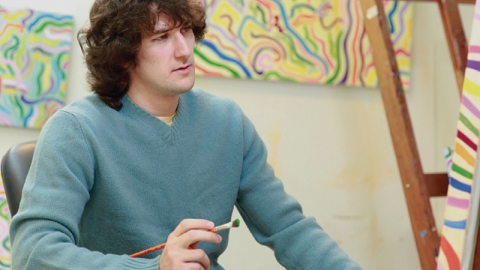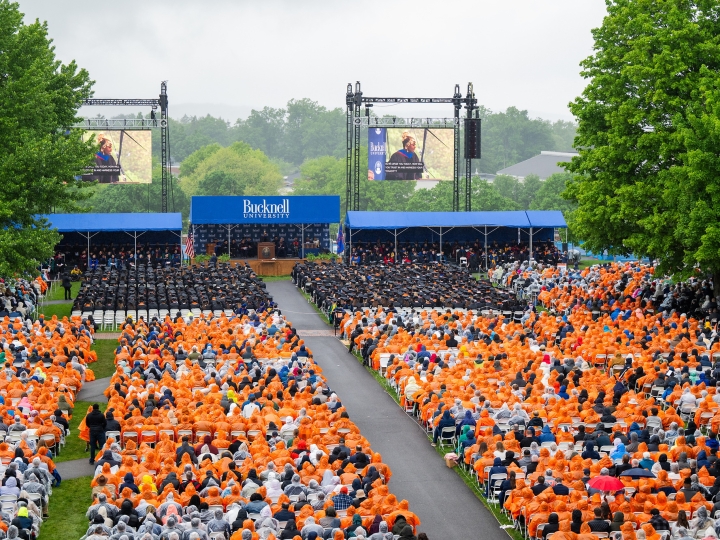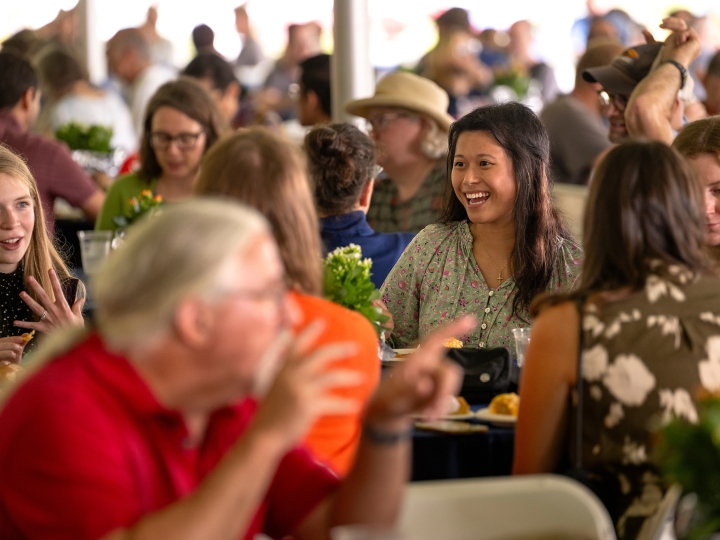
Developing an Artistic Voice
April 13, 2016
Frederick Schroeder '16 explores anxiety through painting.
Seniors sort out the challenges of developing a body of work for a culminating exhibition.
Frederick Schroeder '16 was having recurring nightmares — his sleep disrupted by anxiety. As a coping mechanism, Schroeder turned to his interest in inter-disciplinary fine arts. The studio art major revisited each nightmare and wrote a memoir about his experience, but as he developed the concept for his senior art project, he began to look beyond himself. Building relationships between art and people just might offer a way to share the often-taboo experience of anxiety.
Schroeder is taking the Senior Projects in Studio Art course this year with Professor TuluBayar, art & art history. During the fall, students developed their ideas, met to discuss them and began creating and critiquing their work. This spring, they further refined their projects while writing artist statements, preparing snap talks and planning Mindscape: the Annual Senior Student Art Exhibition, held April 12–May 1 in the Samek Art Museum.
Schroeder’s collection of paintings, Night Sweats, has evolved as he’s developed his painting style. "I’ve illustrated each story with a dreamlike quality," he says. "Over time, through natural progression and critical feedback, I’ve loosened and abstracted the style to further challenge the viewer." Standing in the middle of a second-hand bedframe that will be part of the exhibition, he says that each new painting has become his favorite. "I think that’s because I’ve been getting comfortable with the style and gradually dared to do new things with it."
Bayar says she is impressed with how the students have embraced critical discussions of their work. "They are very honest with each other," she says. “We have respectful tension in our discussions and something positive always emerges because everyone reflects and then takes a break and then reflects again. If you’re going to be working in any field, not only in the arts, you have to learn how to take criticism and interpret it. It’s not personal. I think it should happen in every class because it prepares you quite well for the real world. You learn how to take and give feedback."
Vicki Klein '16, who is exploring body image through photography, agrees. "We get to talk about our projects for hours," she says. "Being able to spend that much time helps me discover what it is I’m trying to communicate, what’s successful and what’s not — and what next step I need to take."
Klein, a double major in studio art and psychology, started by deciding to include women as collaborators so she could explore the variety of experiences women have with body image. As her project progressed, it evolved from interpreting her collaborators’ stories through painting and photography to collecting selfies from women and responding to them by taking her own photos that reflect how she sees them. Her final collection will focus on how people represent themselves juxtaposed with how others see them.
Creating art on her terms has been liberating for Klein. "This is the first time I’ve had the opportunity to make whatever is in my mind without a prompt," she says. "Having that freedom is kind of terrifying but also fun and interesting. It’s helping me to discover what I like to create."
The process has taken her in directions she hadn’t imagined. Through peer and faculty critiques, she changed her focus as her project evolved. "Each new direction has been triggered by reflection," Klein says. "It’s almost like starting a new project at each phase."

The same has been true for art history major Kate Miller '16, who was asked to join the exhibition due to the success of her Advanced Digital Photography project on visual paradox, which explores the duality of pre- conceived gender roles. Inspired by feminist film theorist Laura Mulvey, who addresses the practice of women being cast as objects to reflect male heroism in feature films, and conceptual portrait photographer Cindy Sherman, Miller began exploring power dynamics between men and women in the workforce.
“I didn’t start with the art — I started with the theory,” she says. “As an art historian, I appreciate the beauty and technical aspects of a work of art, but my practice of art is strongly grounded in the debate around what makes art important — things like aesthetic value, political influences and how it fits into the timeline of art history.”
Miller photographed women wearing stereotypically female, then male, clothing to address how gender influences societal roles. She was surprised by how much the models altered their posture when they changed clothes and how they brought new energy to each character as the shoots progressed. She hopes the viewer’s experience is powerful, no matter how her collection is interpreted.
“Social-driven pieces resonate with me, so I’m attempting to create visual interest while provoking the audience,” she says. “I don’t want to create a specific identity for these characters, but I do want to capture their humanity.”
The yearlong experience has enabled the seniors to develop their artistic voices and skills they’ll use long after the exhibition closes.
“This process has been a challenge for me because it required working for months developing my concept and technique,” says Schroeder. “When I was first experimenting with this painting style, I wasn’t sure of myself. I’m really glad that I had to keep going.”
Learn more about Frederick Schroeder’s painting and writing at frederickiv.com.

